Top 10 Things to Do in Pucon, the Gateway to Chile’s Lake District

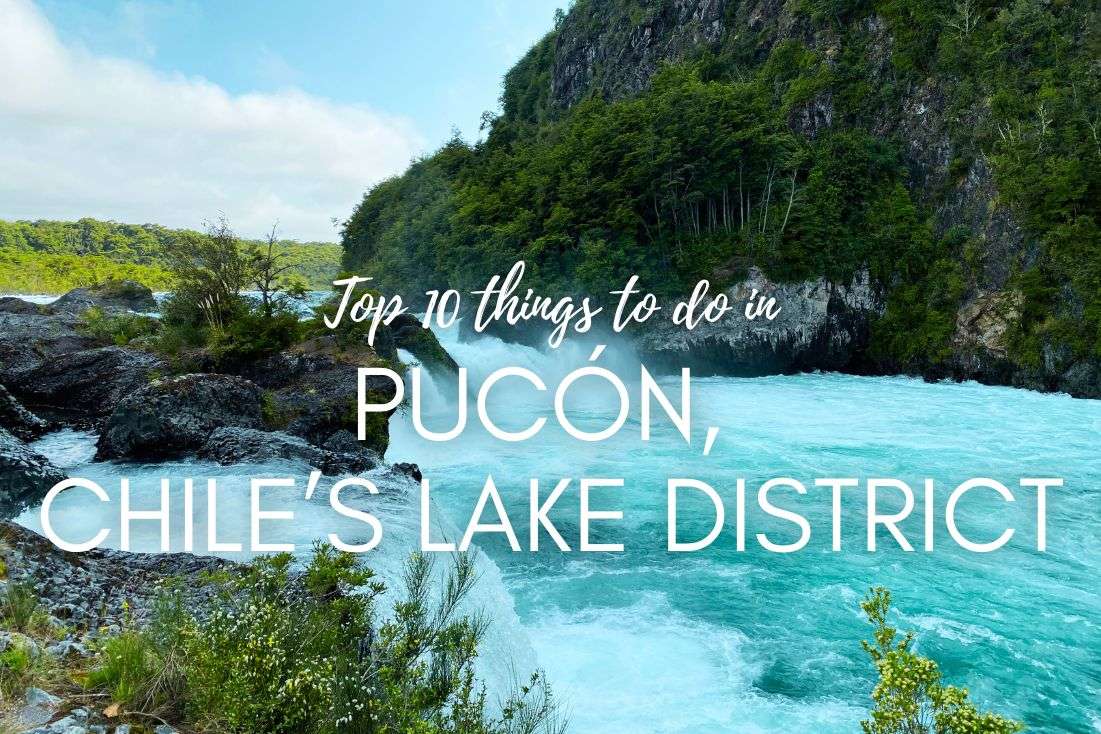
Chile’s Lake District, nestled in southern Chile, is a place that feels like it was designed for adventure and awe. Arguably the most popular tourist destination in Chile stretches over 340 km between Temuco in the north and Puerto Montt in the south.
This beautiful region is where warm thermal lakes meet volcanoes and fierce rivers, creating a unique mix of adventure, relaxation, and stunning landscapes. There are more than a few places within the national parks that offer awesome views and well-marked trails—the ingredients of a perfect travel recipe!
Base yourself in Pucon and get ready for a whirlwind few days exploring the Lake District! If you're looking for inspiration, check out these best things to do in Pucon Chile.
Why is Pucon Chile famous?
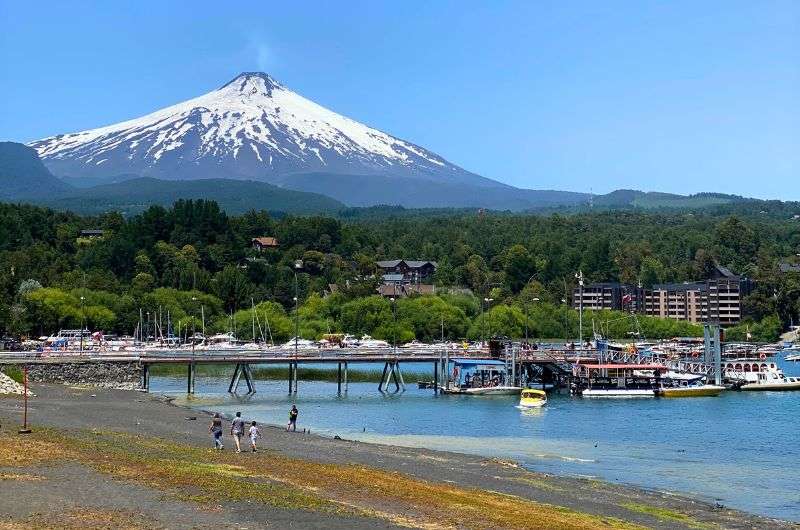
Pucón is your gateway to the Chilean Lake District
Pucon Chile is the gateway to the Lake District, which offers a more accessible blend of adventure and leisure when compared to Patagonia (rugged glaciers and windswept plains) and Torres del Paine (jaw-dropping mountain peaks and iconic treks). Here, you can enjoy exhilarating volcano climbs one day, a variety of outdoor activities the next, and relax in natural hot springs to round it all off—all surrounded by lush forests, many lakes, and serene scenery that feel like a South American version of the Swiss Alps.

What are the Top 10 Things to Do in Pucon Chile?
- Climb Villarrica Volcano for thrilling views.
- Marvel at Petrohué Waterfalls’ turquoise cascades.
- Visit the iconic Osorno Volcano.
- Explore Vicente Pérez Rosales National Park.
- Raft or kayak the glacial Petrohué River.
- Tackle the serene hiking trails of Huerquehue National Park.
- Discover ancient trees in Alerce Andino National Park.
- Wander Conguillío National Park’s volcanic beauty.
- Relax in charming Puerto Varas.
- Base yourself in Pucon for adventure and comfort.
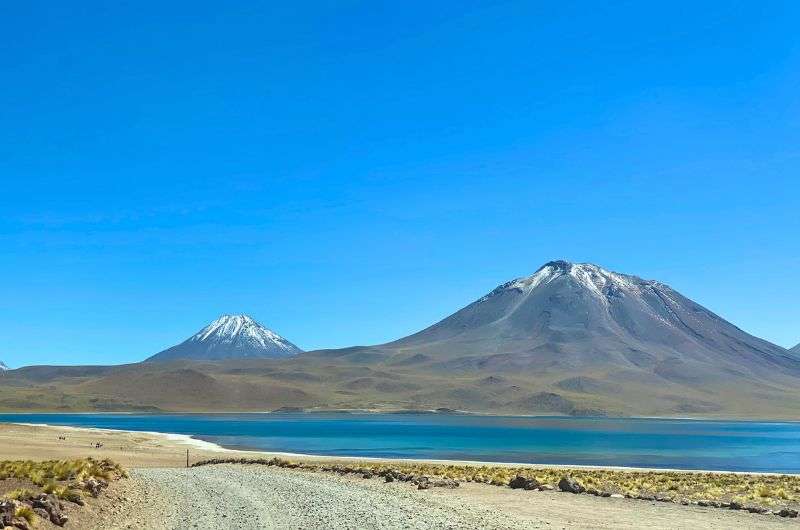
Let's take a look at all the highlights of Pucón
Sometimes, all you need to do is take the first step... I've filtered out the best hotels in Pucón for you
Save it for yourself to come back to later, or share with your friends on social media!
I've already planned your ititnerary for the trip, complete with my travel tips.
Top highlights of the Lake District (Chile)
Chile’s Lake District offers a mix of stunning landscapes, thrilling outdoor activities, cultural charm, and visible signs of volcanic activity in the area. Here’s a snapshot of what to explore:
Outdoor adventures
- Climb Villarrica Volcano for a once-in-a-lifetime view. This was the clear standout of Lake District experiences in my book!
- Hike through Conguillío and Huerquehue National Parks.
- Kayak or raft the Petrohué River rapids.
- If horseback riding tours sound like your thing, go for it—just don’t expect me to join. With my horse allergy, I happily passed on this activity. Some travelers I met raved about the scenic trails near Villarrica Lake where horses happily roam (with tourists on their backs). If you’re not me, it’s probably worth checking out.
Natural beauty
- Soak in the lush surroundings of Termas Geométricas hot springs (pun intended!), one of the many hot springs you can find in the Lake District.
- Marvel at Petrohué Waterfalls' turquoise waters.
- Walk amidst ancient Araucaria trees in Alerce Andino National Park.
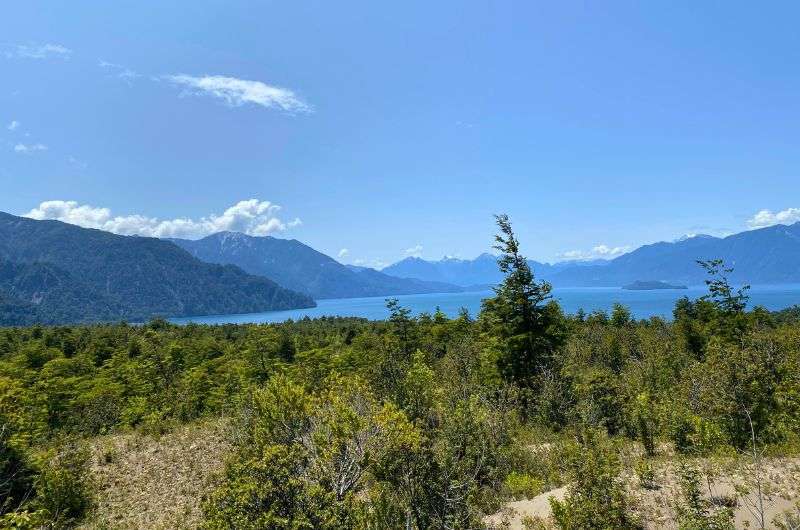
The beautiful nature of Pucón
Charming towns
- Pucon: Adventure capital with lakeside charm.
- Puerto Varas: German-inspired architecture and Lake Villarrica views.
Practical tips
- When to visit: Best months are September to December to avoid crowds and horseflies.
- What they don’t tell you: Don’t go in January, the horse flies will eat you alive!
- Essential gear: Pack hiking boots, insect repellent, and a swimsuit for thermal baths.
- Stay on the trails: Keep in mind that some sections of the Lake District fall within private protected areas, so check trail access and permissions in advance.
- Where to stay: My picks are Hotel Antumalal in Pucon and Hotel Cumbres Puerto Varas for easy access to attractions and a brilliant night’s sleep.
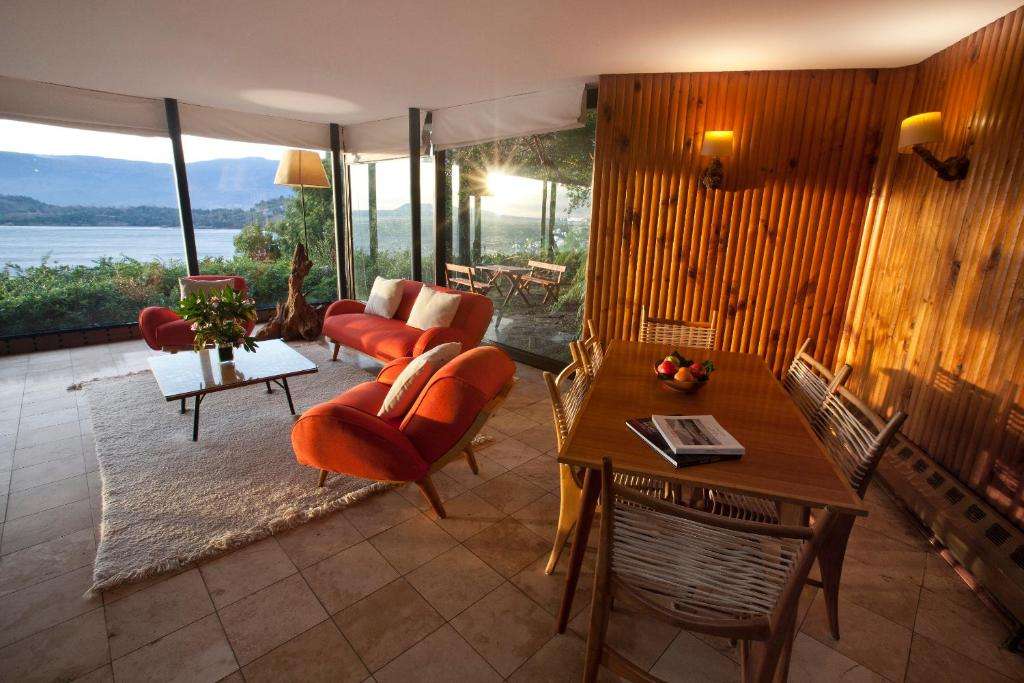
1. Villarrica Volcano: a thrilling climb to South America’s fiery crater (yes, an active volcano!)
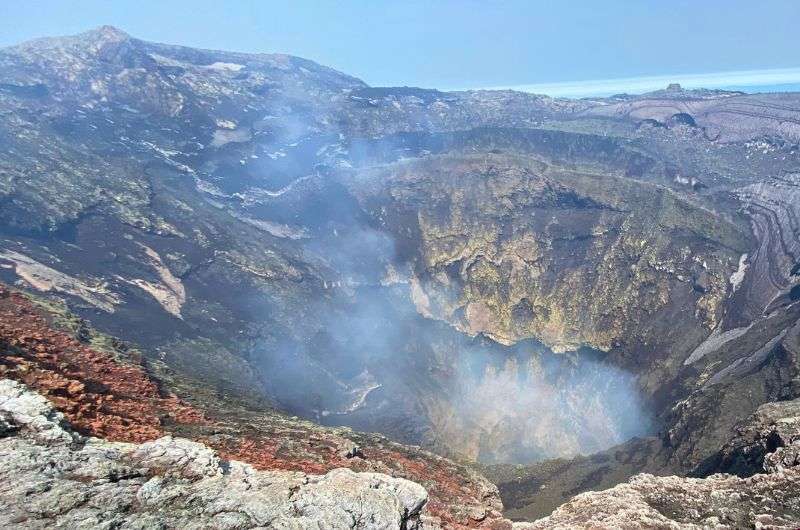
The active Villarrica volcano
Chile has countless volcanos, but Villarrica is the real deal. It’s the most active volcano in South America and a highlight of Villarrica National Park.
That said, it’s no cakewalk. More of a Vietnam-like experience (especially with the surrounding hills covered in mild jungle). Plus, it’s the the most active volcano in South America!
“But what about the climb?” I hear you asking. The ascent to Villarrica crater was one of the deadliest, most challenging, most awesome experiences of my life! The sight of ancient lava flows cutting through the landscape was both surreal and humbling. Imagine ascending from 1,500 m (4,921 ft) to 3,000 m (9,842 ft), sometimes in 45° gradient with:
- ice axes and crampons, because half of the volcano is heavily glaciated, and
- a gas mask because all the sulfur fumes close to the top make breathing really hard.
And all of that within about 3 hours. Deadly combination, considering there are 400+ m (more than 1,300 ft) of the glacier!

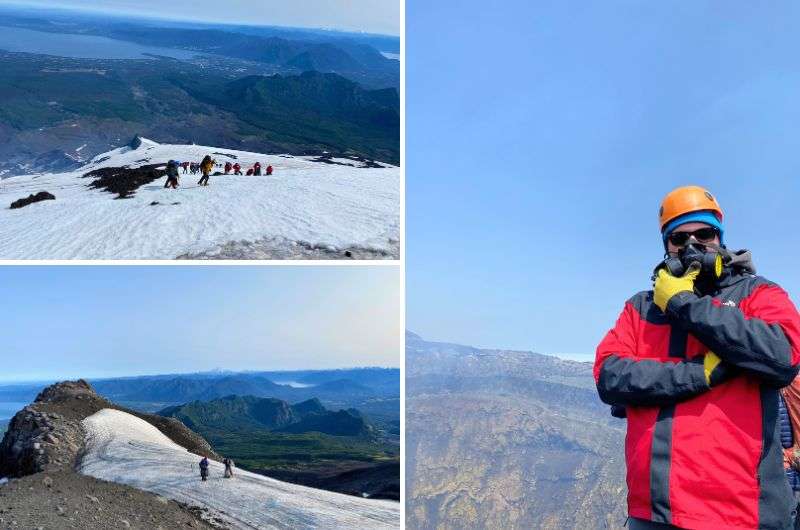
Altitude sickness on Villarrica troubled me a lot, but the oxygen mask and the views had my back
I survived up there only because the views and the feeling were amazing! I literally felt the warm ground on the top because the lava is so close to the surface. If you’re lucky, you can see the bubbling lava over the edge of the crater.
Sometimes, tourists even manage to witness an eruption. But don’t worry, since the volcano always spews lava on the same side, the expeditions are always safe and sound. I didn’t feel that way, with my feet slipping around on the glacier close to the crater, but I was told I’ll be just fine. And here I am writing about it, so I am proof it is, in fact, safe(ish).
Fun fact: The indigenous Indian tribe Mapuche calls the volcano Rucapillán, meaning “Home of the Great Spirit”, and I believe they know what they’re talking about. The Mapuche resisted Spanish colonization for over 300 years, making them one of the few indigenous groups in the Americas never to be fully conquered. Today, their influence is still felt strongly in the Lake District.
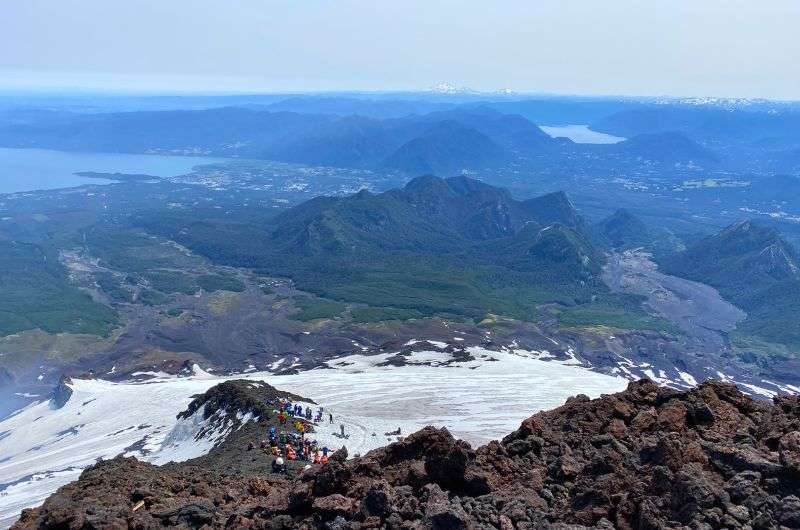
And we went back down the volcano on our butts!
Sad fact: Unfortunately, nowadays the Mapuche have to fight all over again over their land and living space, this time against oil and gas companies.
And now the coolest thing that I did at Villarrica: To save us from the long descent, we slid down the volcano on plastic sled! It took us about an hour, and it was super fun. From now on, I think I won’t consider any hike complete until I slide back down the mountain!
I put together my personal experience and detailed info about the hike in my Villarrica Volcano Hiking Guide.
Practical info
- Book a tour guide on site. Not only do you need a permit if you go alone, but it’s also a too dangerous to do so.
- Prices for a Villarrica ascent tour start around CLP 190 000 (USD 190) and that includes permission, a guide, and the complete gear.
- The meet-up at 7 am in front of the agency and the whole trek takes around 7 hours (3-4.5 up and 1.5 hours down).
2. Petrohué Waterfalls: Chile’s stunning turquoise cascades
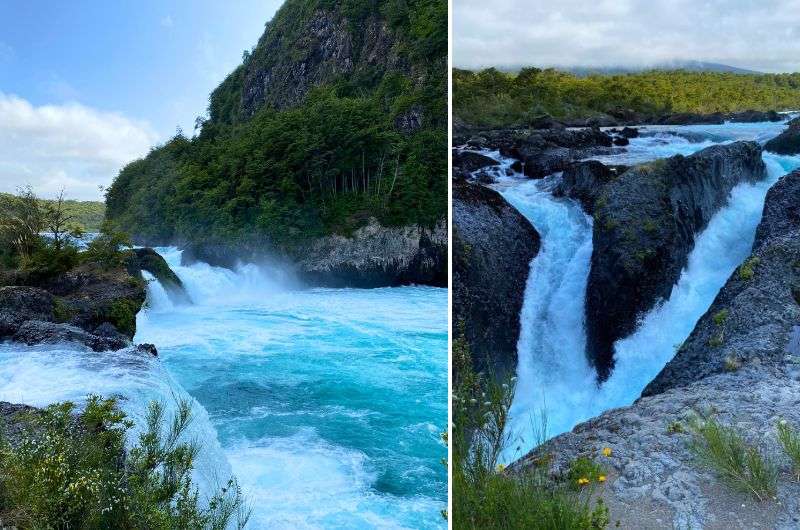
Petrohué Waterfalls
This one was a surprise for me. I thought it would be just ok, but it was actually one of the most beautiful waterfalls I’ve ever seen. In my defense, I’ve seen plenty of instances of “it’s an impressive waterfall!” that turned out to be little more than a glorified trickle, so my skepticism was warranted. But this? This was the real deal.
The waterfalls are a part of the Saltos del Rio Petrohué Park located right next to Osorno volcano in the Lake District (see next item on this list). That means the incredibly blue water runs down the black volcanic rock canyon carved by the lava from Osorno.
I spent two hours there exploring the area on the short Petrohué Waterfalls hiking trail, which is suitable for anyone. Even if you’re more of a “sit and enjoy the view” kind of person, this spot delivers. Now I understand why it’s one of the most visited places in Chile.
Pro tip: Go early in the morning or late afternoon to dodge the crowds—unless you enjoy spending your waterfall time elbow-to-elbow with strangers trying to take selfies. Also, wear sturdy shoes—the rocks around the falls can be slick, and you don’t want your graceful vacation photos to include an unexpected tumble.
3. Osorno Volcano: a picture-perfect peak with unforgettable views
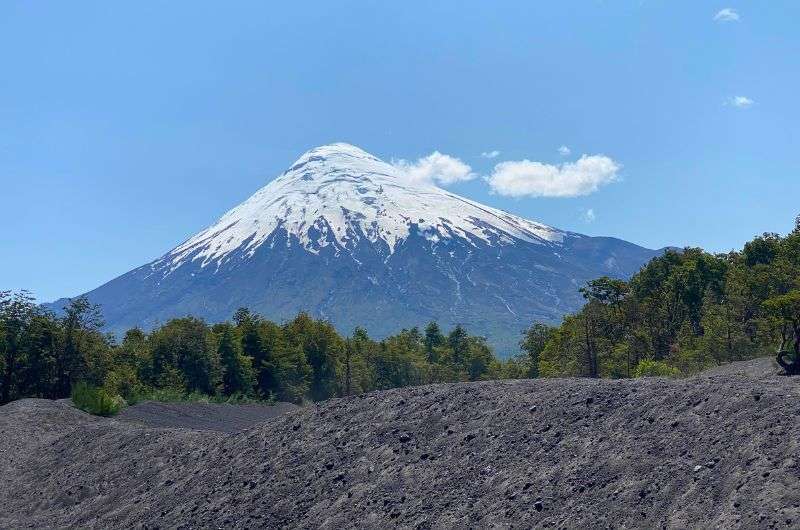
Osorno Volcano
One of the prettiest volcanoes in the world is also to be found in the Vicente Perez Rosales National Park (I’ll talk more about the park below). Osorno Volcano has a perfect conical shape with a glacier on the top, which makes it look a bit like the Paramount Pictures logo (which is by the way officially inspired by Ben Lomon peak in Utah) or Mt. Fuji in Japan. Standing in front of it, I half-expected a lion to roar and stars to circle around the peak—it’s so dramatic.
Watching the glacier sparkle in the sunlight is worth the visit alone, even if you’re not up for the climb.
Practical information
- If you want to conquer Osorno, you'll need a local climbing agency to get your permission from CONAH (National Forest Corporation).
- The most popular and credible agency is Huella Andina.
- The ascent begins before dawn and includes a sleepover in a hut, so clear the night and a full day in your schedule. Unfortunately, that was the very reason I chose not to participate, as sleeping in a tent is a big no no for me. I’ll hike a volcano, but let’s not push our luck with my camping skills.
- The entrance fee per person is CLP 220,000 (USD 225 USD).
Pro tip: Even if you’re not climbing, drive up to the Osorno ski resort for jaw-dropping views over Lake Llanquihue. The road itself is an adventure—think hairpin turns and sheer drops that will have you reconsidering your life choices—but the panorama at the top is unbeatable.
4. Vicente Pérez Rosales National Park: Chile’s oldest national park
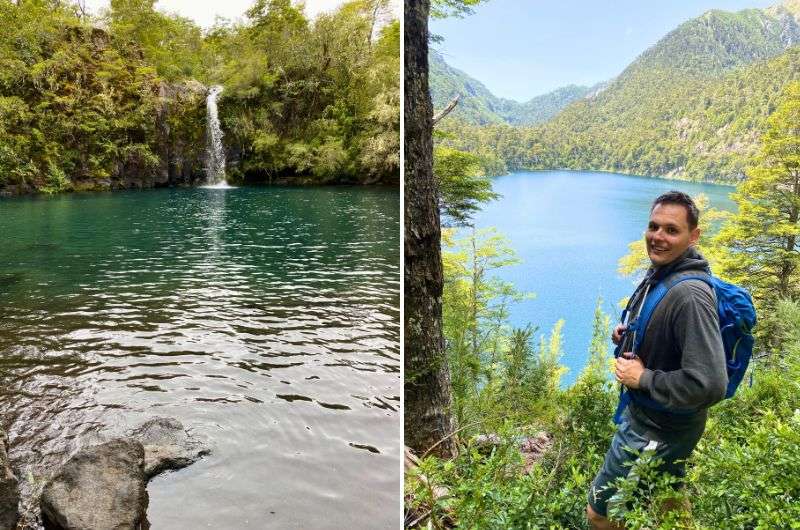
Me in the Vicente Perez Rosales National Park
The Vicente Perez Rosales National Park stretches all the way to Argentina and is perfect for an entire day trip of exploring. It’s Chile’s first national park, established in 1926.
It’s named after Vicente Pérez Rosales, a 19th-century explorer and writer who was the main guy promoting European immigration to southern Chile. He helped shape the multicultural identity of the Lake District.
Lake Todos los Santos
Lying below the slopes of Osorno Volcano, Lake Todos Los Santos and its emerald waters are a must-see stop in the Chilean Lake District. It’s important mainly thanks to the transportation route to Argentina. But it also makes a beautiful setting for a hike with a views of Osorno. I can recommend these two:
- Desolation Pass (hard, approximately 7 hours)
- Sendero Los Alerces (moderate, approximately 4.5 hours)
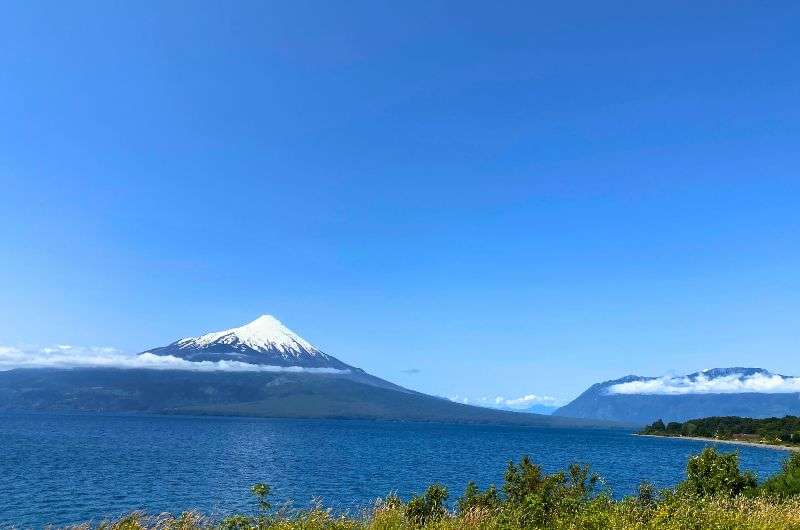
Todos Los Santos lake
If it wasn’t for those damn horseflies, it would’ve been a really nice hike. I came back to the hotel looking like I’ve just spent half a year on a deserted island at the mercy of those bloodthirsty bastards.
The route of the two hikes intersects after 4.5 km (2.8 mi), so you can combine them if you want to.
HORSEFLY WARNING:
I was really excited about this trip, but I quickly learned a hard lesson. What do I mean? Well, it wasn’t a big, angry guy I crossed paths with, nor a strenuous hike. It was huge, blood-sucking flies!
They are part of the Tabanidae family endemic to Chile and Argentina and they feed on the blood of mammals. All mammals!
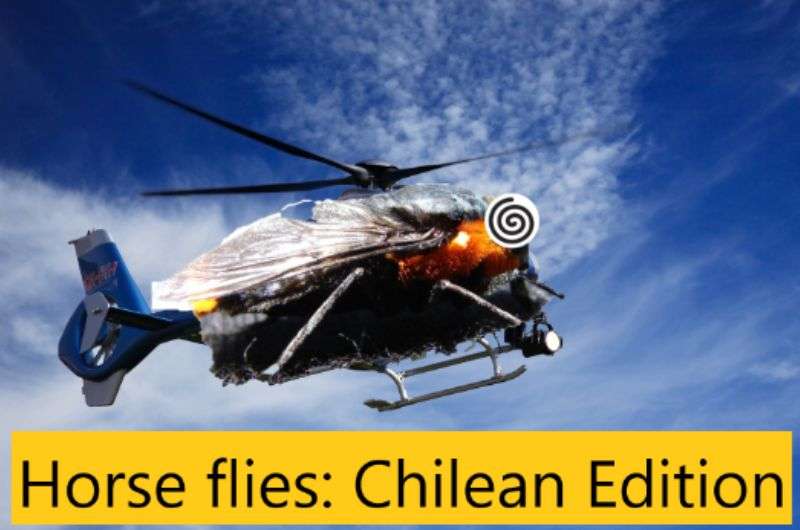
The evil Chilean horsefly
In Spanish, they call them el gran tirano, I think that’s fitting. Just big tirants. Judging by the sound they make, and their size, they’re basically small helicopters.
On the bright side, horseflies appear in this area only in January, a fact I wish I’d known before my trip in January.
Pro tip: Horseflies are attracted to bright colors, so choose your outfits carefully. Of course, I was dressed in white....
5. Rafting and kayaking in the Chilean Lake District: the glacial rapids of the Petrohué River
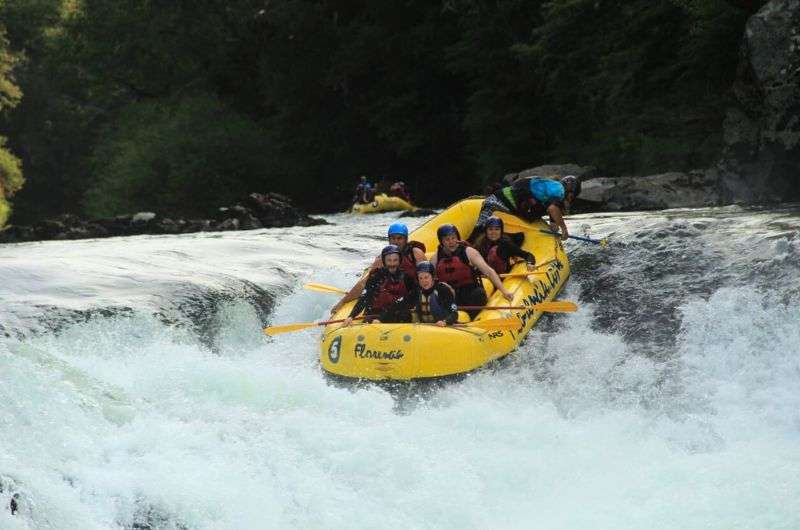
The navigator looks like he’s done with us, but he’s actually just navigating the raft.
I’m an inquisitive creature by nature, so going down a wild river in Chile is something I am very content with. It was super fun!
What makes Petrohué special?
The Petrohué is fed by glacial meltwater, which means it’s as clear and cold as it gets. As you navigate the rapids, you’ll be treated to views of Osorno Volcano and lush green valleys. It’s basically like rafting through a National Geographic cover.
What to expect
Most sections of the Petrohué River are class III-IV rapids, meaning you’ll have just the right mix of thrills and (controlled) chaos. Perfect for beginners with a bit of skill who want a taste of adventure without things getting too extreme for comfort.
There are plenty of rafting and kayaking options in the Chilean Lake District and it’s a super cheap activity (for what you get)! I decided on taking a half-day trip on Petrohué river with Ko’Kayak and was thrilled. I would stick around for more if I knew it was going to be so cool.
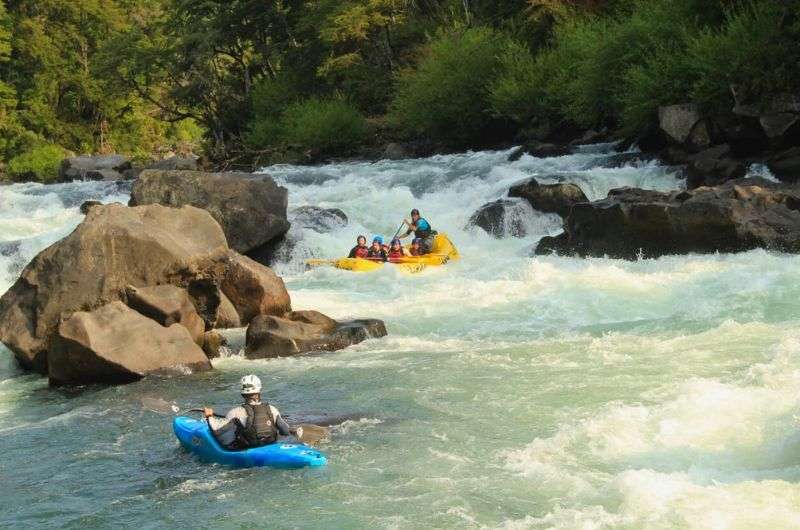
Get ready for the river to be wild! It’s a real adrenaline rush
- Gear up: The tour agency will provide everything—life jackets, helmets, and wetsuits. All you need to bring is a willingness to get soaked and a decent sense of balance.
- The experience: Expect plenty of splashy fun, a few screams (of joy, probably), and some truly epic scenery. If you’re lucky, you might even spot a kingfisher diving into the water mid-ride.
Pro tip: Don’t forget to smile for the camera! Most agencies have photographers stationed along the route to capture your “I’m totally not scared” face.
Costs and booking
Prices hover around USD 40 per person for a half-day experience, making this one of the best-value adrenaline rushes in the Lake District. Be sure to book in advance during peak season, as spots fill up fast.
6. Huerquehue National Park: discover serene lakes and ancient landscapes
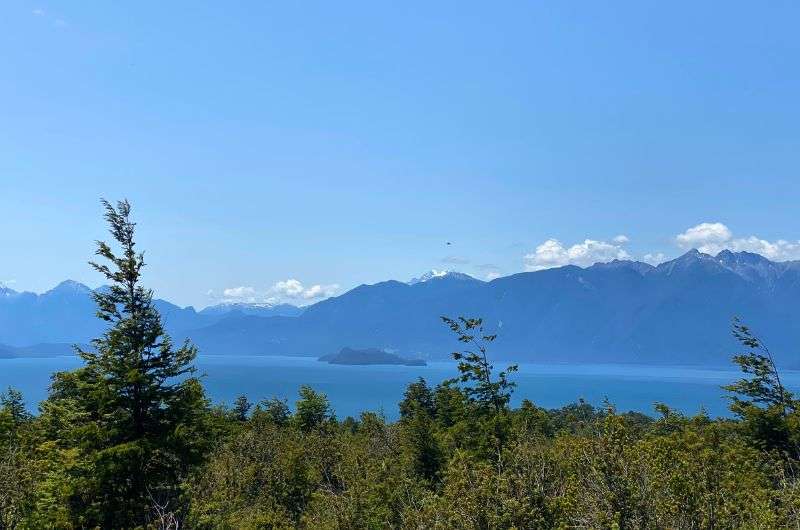
Huerquehue National Park
Huerquehue is one of Chile’s oldest national parks (dating back to 1912) and a treasure of the Lake District. It’s famous for its lush scenery, serene hiking trails, and proximity to Lake Villarrica.
If you read my other articles, you already know I’m not easily amazed. In Chile, I was amazed all the time, and Huerquehue National Park in the Lake District was one of the reasons.
Beware! While admiring the magnificent landscapes, you might get startled by a sudden encounter with the Chilean rose tarantula (Araña Pollito). It’s one of the friendliest tarantula species, which is why it’s popular as a pet. In fact, many US and European pet stores sell this species.
Luckily, these cute, fluffy spiders are nocturnal, so the chance of meeting one is pretty slim.
Well, now I’m sure you’re getting really excited about the hiking options, right? Check out these two trails—and keep an eye out for spiders!
Huerquehue National Park Main Trail
- Difficulty: Medium
- Distance: 27 km (16.6 mi)
- Elevation Gain: 1,535 m (5,036 ft)
- Time: Approximately 10 hours
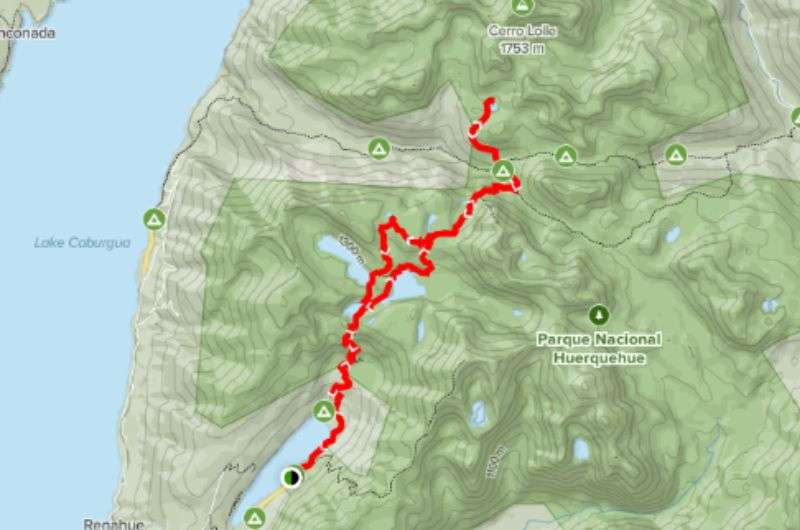
Map from Alltrails.com
The Main Trail is great if you have enough time to explore all the highlights. This trail starts from the CONAF Camping site. There are other camping sites on the way if you wish to stay in the wild, but I prefer the comfort of a nice hotel, thankyouverymuch.
Along the route, you can enjoy lake views as well as mountains towering in the background. And most importantly... you’ll escape the crowds!
Huerquehue Lake Trail
- Difficulty: Medium
- Distance: 10.5 km (6.5 mi)
- Elevation Gain: 689 m (2,260 ft)
- Time: Approximately 5.5 hours
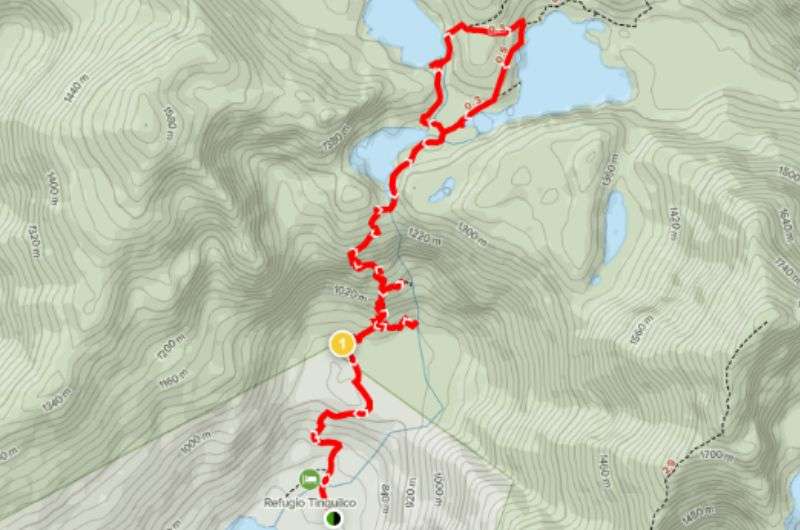
Map from Alltrails.com
Due to time constraints in my Chile itinerary, I chose the shorter Lake trail, which is basically a trimmed loop version of the Main Trail. I particularly enjoyed the part further up the trail with several lakes next to each other and every single one unique in its beauty.
I made it in 4 hours, but I imagine the route can get pretty muddy in wet weather, so bear that in mind when planning the trip. You may end up walking for quite a bit longer if the path is soggy.
The trailhead is at the kiosk under the mountain.
7. Alerce Andino National Park: explore Chile’s oldest trees and serene trails
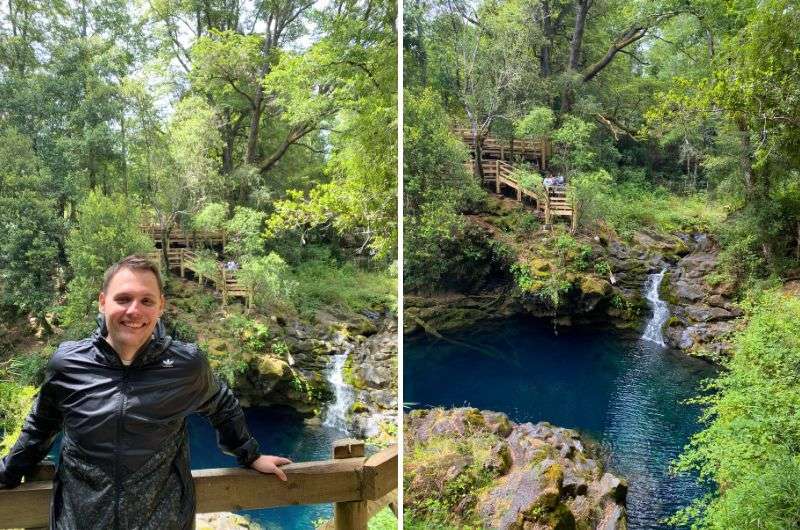
Exploring the Alerce Andino National Park
Even though Alerce Andino is only a few hours' drive from the lively Puerto Montt, it’s one of the less crowded parks.
It’s a haven for nature lovers and travelers looking for peace and solitude, offering trails that wind through ancient forests in a privately protected area dedicated to preserving rare and endemic species.
Covering over 393 square kilometers (151 square miles), the park is home to more than 50 glacial lakes and some of the oldest trees in the world. The iconic Alerce tree, often compared to California’s redwoods, can reach up to 60 m (197 ft) tall and live for over 3,000 years!
You can hike in Alerce Andino National Park for hours and not meet a single soul. On the other hand, you can’t get lost, as all the trails are well marked. It’s also ideal for hiking with the family since most of the trails are ranked moderate or easy.
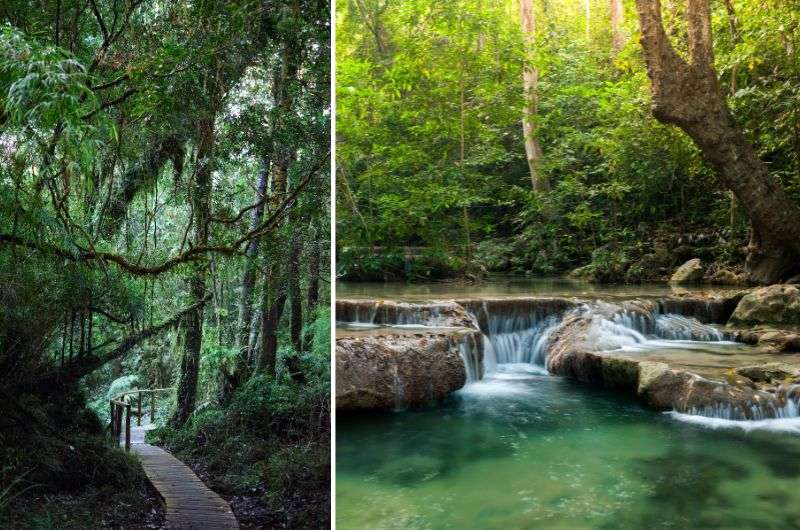
You will mostly have Alerce Andino National Park all to yourself
Some highlights of the park include:
- Sargazo Lagoon: A tranquil glacial lake surrounded by dense forests. The 2.5-hour hike to the lagoon offers great photo opportunities and a chance to spot local wildlife such as pudús (small deer) and Magellanic woodpeckers.
- Salto Río Chaicas Waterfall: A stunning 30-m (98-ft) waterfall tucked away in the park. The 2-hour trail leading to it is moderately challenging but worth the effort.
- Huillifotem Loop Trail: A short 45-minute loop, perfect for families or those wanting a leisurely hike to enjoy the serene environment without putting in too much effort.
Pro tip: Visit in spring or early summer (October to December) when the trails are lush but not too wet. Pack a rain jacket, as the park’s coastal proximity means weather can change quickly.
Opening hours:
- 9 am to 5:30 pm (last entry at 4 pm)
- Most of the trails are closed during winter due to the large amount of rain (June to August). Always check the latest information before heading out in these months.
Entrance fees:
- Foreign visitors: CLP 6,000 (approximately USD 6.80) per person.
- Chilean citizens: CLP 3,000 (approximately USD 3.40) per person.
- Children and teenagers under 18: Free of charge
8. Conguillío National Park: hike among volcanoes and ancient forests
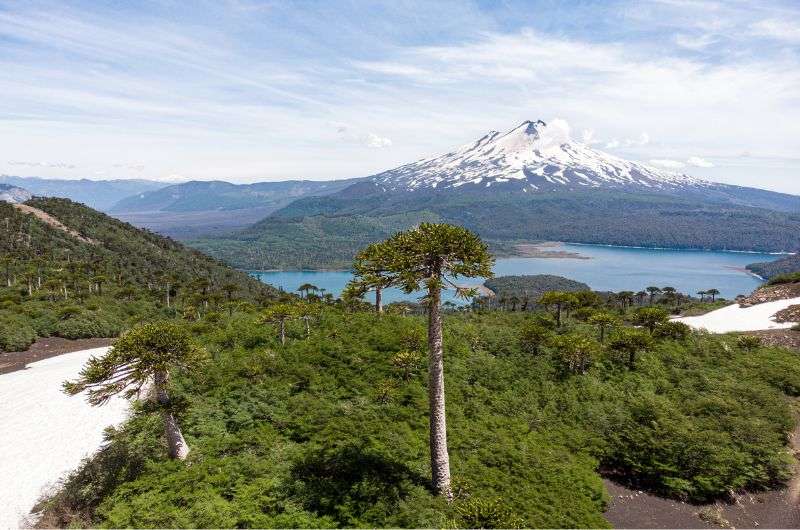
You can see Llaima Volcano in the back
Ready for more nature? Conguillío is home to gorgeous forests, many lakes, and the iconic Llaima Volcano. This park in the Chilean Lake District offers a glimpse of the Andes Mountains—get ready to explore breathtaking landscapes and diverse plant and animal species.
Conguillío’s landscape is Mother Nature showing off, sculpted by time and volcanic events, with dramatic lava flows slashing through the terrain like scars. Toss in volcanic lagoons and jaw-dropping mountain views next to rare species like the endemic Araucaria tree, or cordilleran Cypress, and yeah, you’ll be impressed.
Fun fact: The Araucaria tree, also known as the monkey puzzle tree, is sacred to the Mapuche people, who have used its seeds as a food source for centuries. In the native Mapudungún language, the name means 'water with pine kernels'. You can see why.
What makes it special?
Conguillío is one of Chile’s most geologically fascinating parks, shaped over thousands of years by volcanic eruptions. The Llaima Volcano, still active, looms over the landscape like a brooding giant. Don’t worry—it’s not erupting (today), but its presence adds a certain dramatic flair to your hikes.
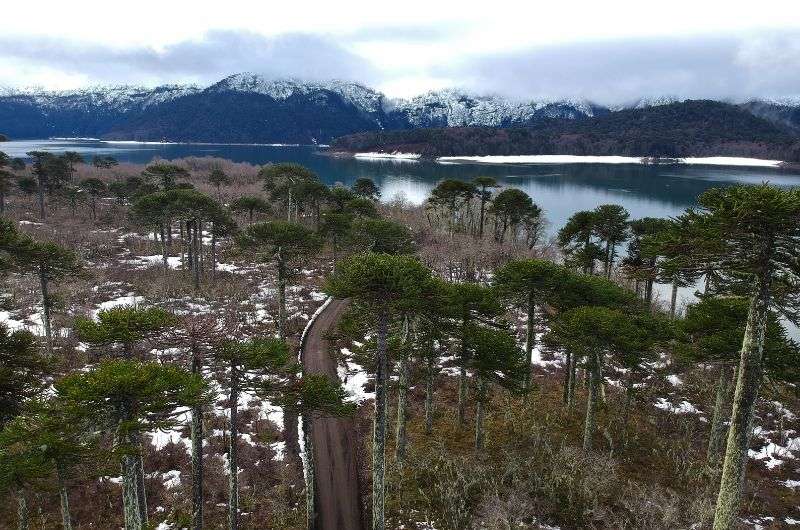
The forests in Conguillío National Park look ethereal
The most popular landmarks: Lake Conguillío, Llaima Volcano, Sierra Nevada mountain range and Araucaria Madre (an Aracauria tree with a 2 m diameter trunk).
Best hikes in Conguillio
- Los Carpinteros Trail (4 hours, moderate)
This trail takes you to the Araucaria Madre, a massive Araucaria tree. It’s been standing here for over 1,000 years, watching hikers huff and puff their way through the forest.
- Sendero Sierra Nevada (4.5 hours, moderate)
This one’s all about the views—think sparkling lakes, snow-capped volcanoes, and postcard-worthy glaciers. It’s a bit of a workout.
- Laguna Arcoiris (30 minutes, easy)
A quick and easy hike for those who prefer their nature with less sweat. The lagoon’s crystal-clear water reflects the surrounding forest in vivid colors—hence the name "Rainbow Lagoon."
Pro tip: If you’re hiking in the summer, pack some serious bug spray. The horseflies here are not only persistent—they’re personal. I was shocked at the size and audacity of those things.
9. Puerto Varas: a charming blend of German heritage and scenic beauty
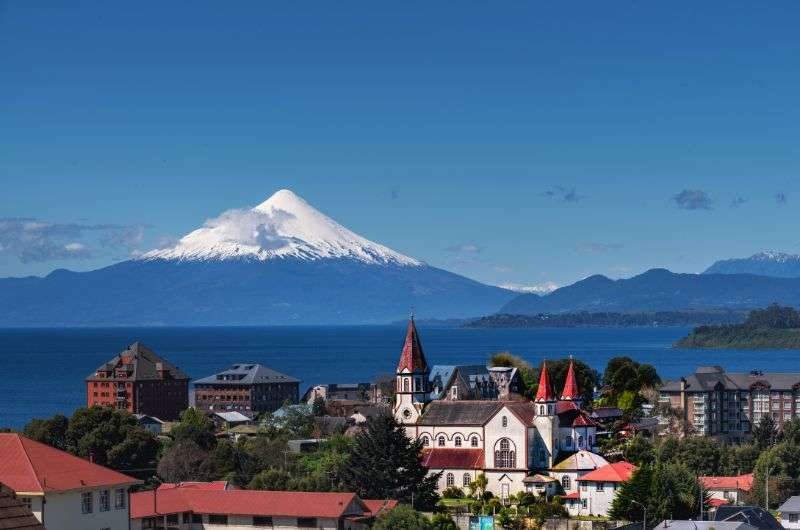
Welcome to Puerto Varas!
Puerto Varas is a small sleepy town in the southern part of Chile’s Lake District, known as a hub for food, culture, and outdoor adventure. Known for its German-inspired architecture and stunning views of Osorno Volcano, the town also attracts (not overwhelming) numbers of visitors with its food scene and a craft beer culture that will delight a whole lot of people, myself included.
So naturally, when I was done with the crowds in Pucon, I moved on to Puerto Varas. As far as adventure goes, it has a lot to offer: rafting, hiking, waterfalls, and national parks. Putting together an itinerary for Puerto Varas is pretty easy:
- Stroll the town and try the Pil Pil dish at a local restaurant
- Hike around the lakes and volcanoes in a nearby national park.
- Pump up some adrenaline while rafting, kayaking, ascending the volcanos, or riding a zip line!
Fun fact: Puerto Varas carries the touch of German architecture as well as Pucon. But with the volcanoes in their backyards and mountain lakes, it feels more like northern Italy or Colorado. Also, with a similar climate. Did you know? Puerto Varas’ Church of the Sacred Heart of Jesus is one of the town’s most iconic landmarks and was built entirely of native wood by German settlers in 1915. The church overlooks the eastern shore of Lake Llanquihue, offering views of Osorno Volcano. It’s now a national monument.
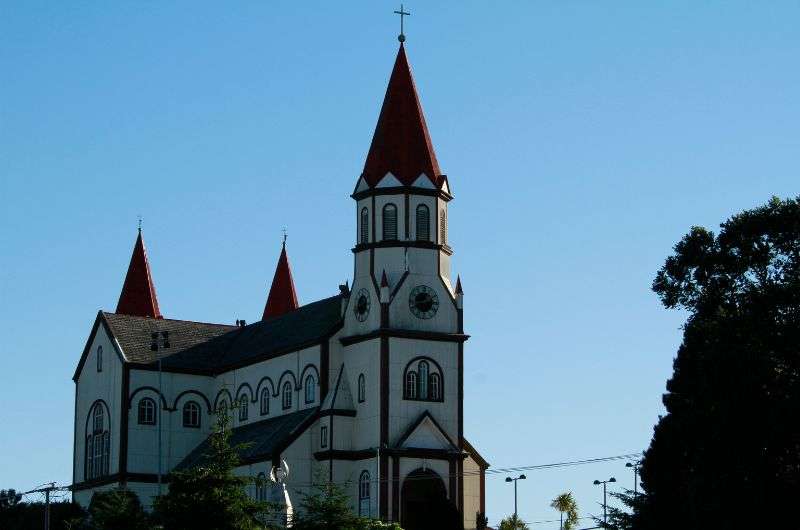
Church of the Sacred Heart of Jesus
Where to eat in Puerto Varas?
- Quintal: My favorite restaurant in town, a standout for its fusion of local and international flavors. The setting with the lake view was just the cherry on the top. Don’t miss their grilled seafood dishes paired with a local craft beer.
- La Gringa Bakery: A cozy spot for breakfast or a mid-morning treat. Their fresh-baked kuchen (German-style fruit cake) and strong Chilean coffee are must-tries.
- Mesa Tropera: Perfect for pizza lovers, this waterfront restaurant offers artisanal pizzas with local ingredients and stunning views of Lake Llanquihue. Food just tastes better with a view, I guess.
Craft beer culture
Puerto Varas and the surrounding region are part of Chile’s growing craft beer movement. The town is dotted with microbreweries that blend German brewing traditions with local ingredients.
Sample these favorites:
- Cerveza Chester: Known for its refreshing ales and cozy beer garden.
- Kuntsmann Brewery: A larger brewery in nearby Valdivia that offers traditional German-style lagers and stouts.
- Cervecería Salzburg: A small family-run operation with excellent amber ales.
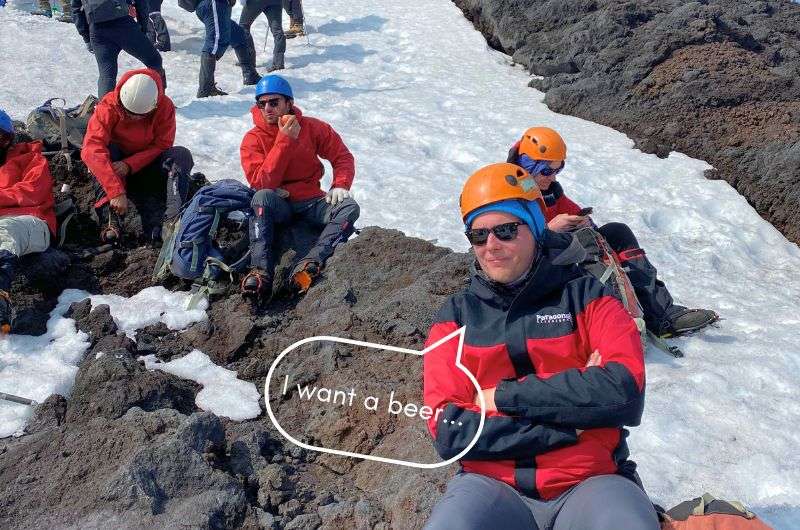
I'm Czech and I like good beer. I also like to taste beers on my travels. Especially when I'm exhausted like here on the Villarrica Volcano hike
Pro Tip: Pair your beer with a traditional Chilean snack like empanadas or sopapillas for the full experience. Read more about Chile’s best foods and drinks.
Where to stay in Puerto Varas?
Because I’m a meticulous planner, I reserved 4 nights in Pucon and another 3 nights in Puerto Varas to give myself enough time to go overboard on hikes and climbing in the Lake District. You just have to (you’ll see!).
Pro tip: In hindsight, I would’ve scheduled even more time in my itinerary for these places If I had known how beautiful this region is!
- Hotel Cumbres: Hotel Cumbres 5* offers the usual: spa, restaurant, free parking, and gym. But the comfy beds and helpful service are unusual… in the best way possible.
- Solace Hotel: Warm yourself up at this 4-star hotel—the fireplace is perfect after a long day climbing or rafting. Solace Hotel is a home-like haven in the center of the town, only a few minutes’ walk from the lake. The spacious rooms and welcoming staff are especially worth mentioning.
10. Pucon: the ultimate adventure hub in Chile’s Lake District
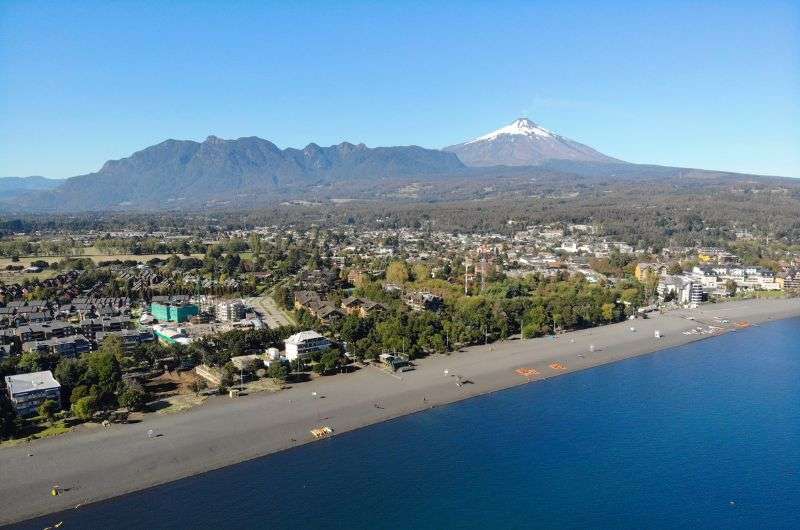
Pucón
Nestled on the northern shore of Lake Villarrica in southern Chile, Pucon is the perfect place to base yourself while exploring the surrounding natural attractions. It’s where you want to sleep when discovering the top things to do in Pucon Chile.
The town offers no shortage of ways to enjoy the stunning surroundings, from hiking Villarrica Volcano to relaxing in hot springs—or even going horseback riding (if horses don’t make you sneeze like they do me).
Pucon was my first stop in the Lake District. I always find it practical to stay in a bigger city and take trips from there. This way you get to explore the surroundings but with the added comfort of all the amenities within reach.
Pucon has a strong German-feel thanks to German immigrants from mid-20th century, but don’t worry, the restaurants are great, and the accommodation isn’t as tacky as in German villages.
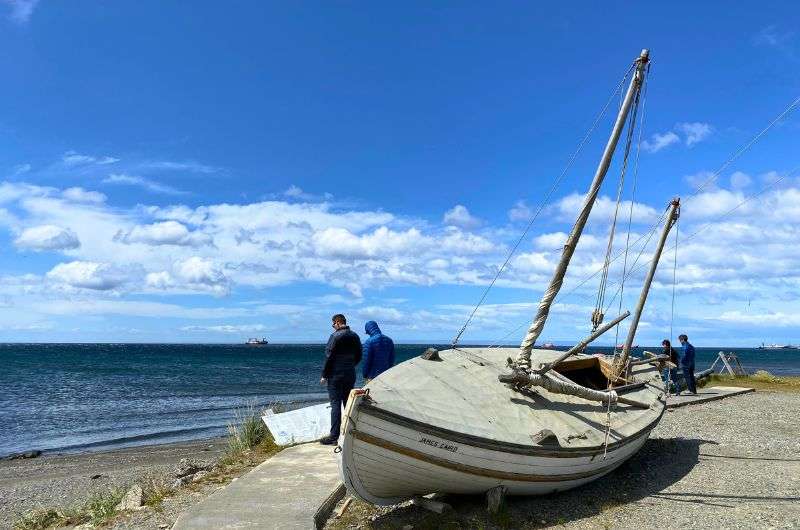
Coastal walk in Pucón
Fun fact: The German influence dates back to a large wave of immigration encouraged by the Chilean government in the 1850s. These settlers brought not only their architecture but also their brewing traditions, which is why the Lake District is known for its craft beer scene.
Today, the town is a major holiday hub for Chileans and foreigners, thanks to the wide range of exciting things to do in Pucon Chile. That said, I recommend visiting from September to December as the town is overcrowded from January to March.
Where to stay in Pucon?
Pucon and Puerto Varas are the best places to stay in Lake District. To enjoy the area to the fullest, it’s best to stay for at least 2–3 days. Here are my top hotel picks for Pucon:
- Maki Hotel: Maki Hotel (3* but feels a lot nicer!) is a cozy haven in the center, with free private parking, a garden, and a terrace with Villarica Volcano views. Staff are extremely helpful and friendly.
- Hotel Antumalal: This stunning, 4-star beachfront boutique hotel is conveniently located on the shores of Lago Villarrica, just 2 km (1.20 mi) from the center of Pucon. Hotel Antumalal boasts a spa, restaurant, and private beach on the shores of Villarrica Lake.
- andBeyond Vira Vira: The Vira Vira lodge, a 5-star property with its own organic garden, is an exceptional accommodation experience. This marvel is modern, stylish, and with huge windows in each room. They offer tailormade tours through Villarrica National Park and a wide range of activities. And what is better than a hot outdoor tub and a fireplace in your room after a volcano hike?
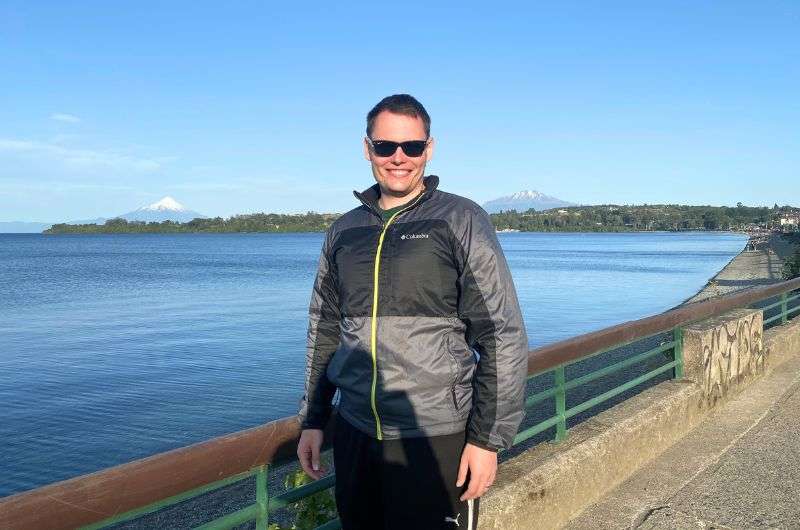
In Pucón you will find both good hotels and good restaurants
Where to eat in Pucon?
The restaurants in the Lake District are generally good. They use the best quality ingredients, often from a fresh market or local farmers.
My favorite spot? As a 100% carnivore, I couldn’t resist trying the grilled specialties in El Fogon de Pucon. I wasn’t disappointed, the food was incredible, the service was fast and friendly.
And there you have it. The top things to do in Pucon Chile and Chile’s Lake District. The obvious next stop? Torres del Paine National Park! Yeah, there’s a reason why Chile is one of my ultimate favorite countries in the world!
Is a car necessary to visit Pucon?
Yes, a car is highly recommended if you want to make the most of your time in Pucon and Lake District in Chile. Sure, you could rely on tours and public transport, but a car gives you the freedom to explore at your own pace. You’ll want to drive to Villarrica National Park, check out the lakes, and chase those incredible views without being tied to someone else’s schedule. I always rent a car when I travel—it’s one less thing to regret later
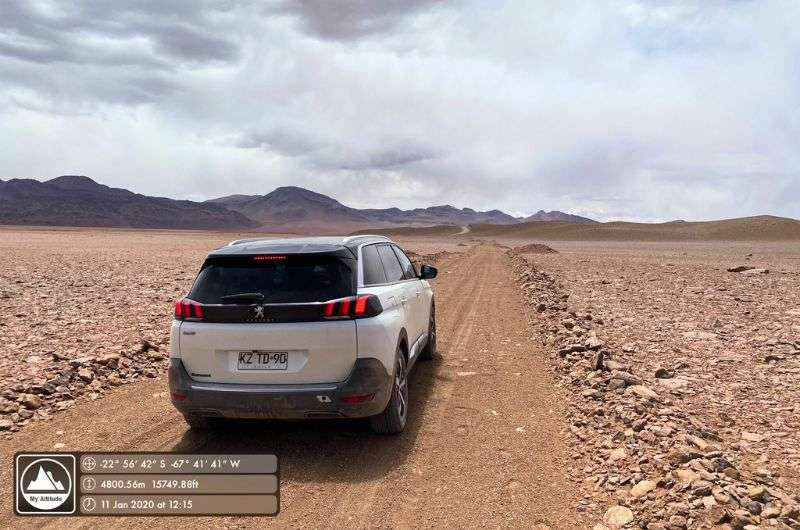
Travelling on your own time in a rental car is simply the best
When to visit Pucon?
The best time to visit Pucon is between September and December or March to May, when the weather is pleasant, and the crowds are manageable. January and February? Be ready for a full house—Pucon turns into Chile’s version of spring break, with traffic and tourists galore. Unless you enjoy battling horseflies and finding no parking, I’d steer clear of those months.
How do I go from Santiago to Pucon?
The easiest way to get from Santiago to Pucon is to fly. LATAM and Sky Airlines offer flights to Temuco, about 1.5 hours from Pucon by car. For a more budget-friendly option, hop on an overnight sleeper bus—not something I’d ever subject mysled to, but I’m putting it out there.
How long to spend in Pucon?
I’d say 4–7 days is the sweet spot in Pucon. This gives you enough time to hike Villarrica Volcano, see the lakes, and explore the national parks without feeling rushed. If you’re an adrenaline junkie (or just really like kayaking), you might want to stretch it out even longer—you still won’t run out of things to do. A small tip: I changed my base to Puerto Varas midway to be closer to some of the other highlights of Lake District.
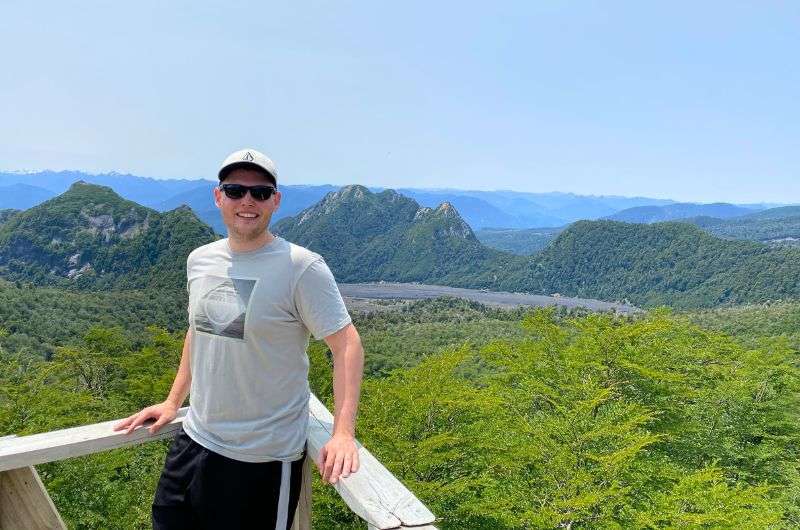
Spend 7 days in Pucón and let me know your opinion
Sometimes, all you need to do is take the first step... I've filtered out the best hotels in Pucón for you
Save it for yourself to come back to later, or share with your friends on social media!
I've already planned your ititnerary for the trip, complete with my travel tips.
You might also be interested in reading:
- 3 Weeks in Chile: The Ultimate Travel Itinerary
- All You Need to Know About Traveling to Chile: 15 Tips and Tricks
- All You Need to Know About Climbing Villarrica in 4 Steps
- 8 Highlights from my Visit to Patagonia
This post contains affiliate links. I earn a small commission if you make bookings through my links, at no additional cost to you. Thank you for your support!




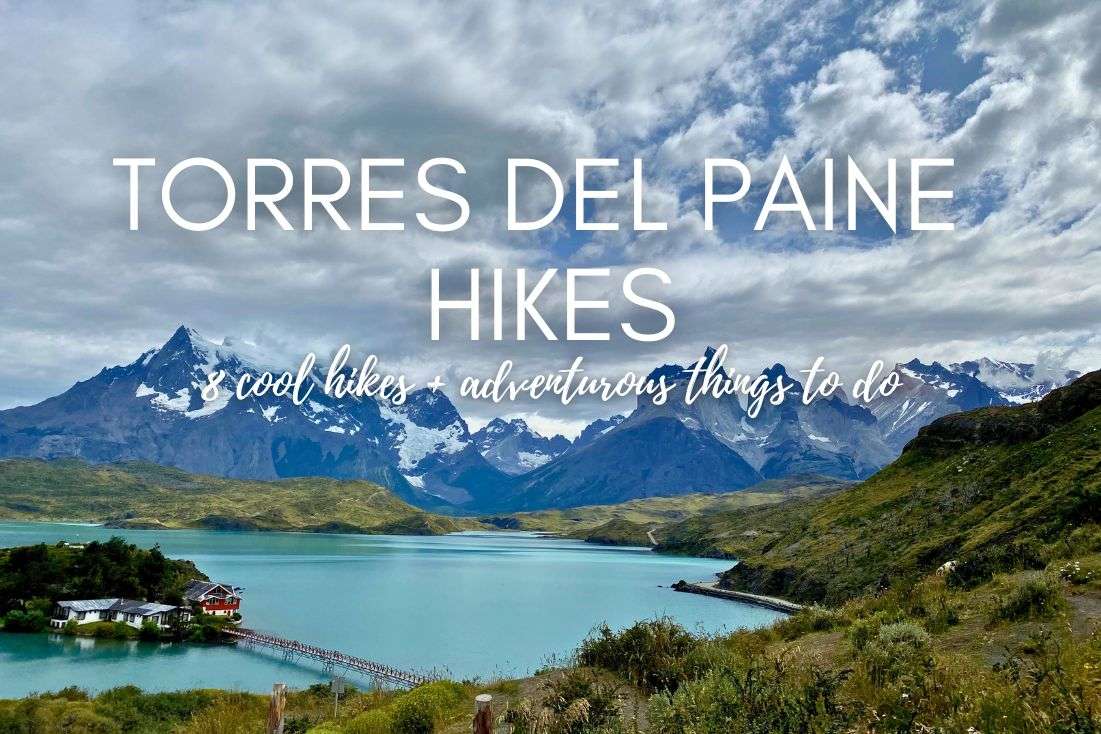

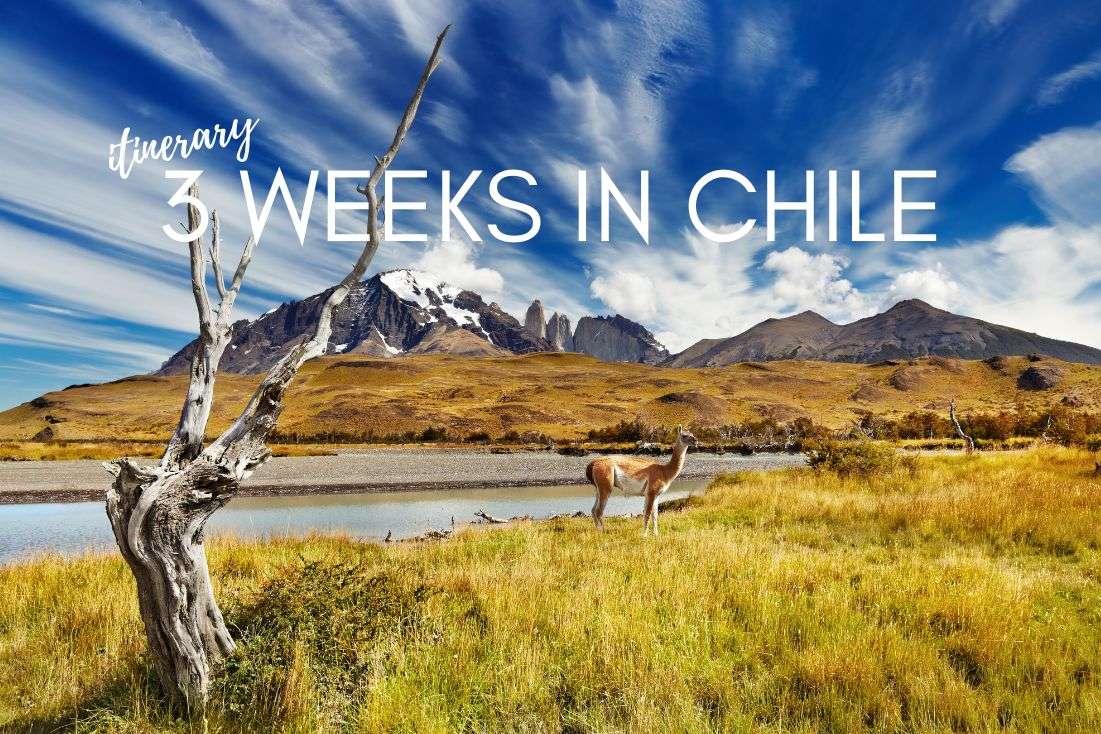



Comments | Thoughts? Give us a shout!